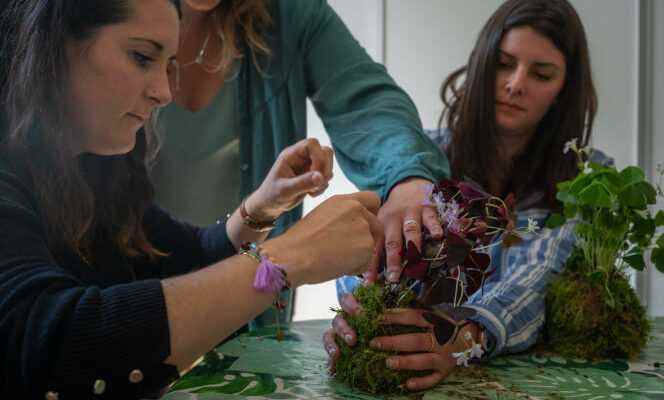” Mr Beard » usually has a rather green thumb, but this weekday afternoon it’s struggling to find its way around the narrow neck of the glass container in front of him. “There, I’m going to be annoyed”, laughs the lad in his thirties, at the prospect of having to deposit, along the walls of the big transparent jar, different layers of materials. A bed of crushed lava, gravel of several colors, a little earth to accommodate a few mini-plants, all closed with a large cork… In less than two hours, Romain (several people requested anonymity), dressed in a “Mister Beard” t-shirt inspired by characters from the “Monsieur Madame” children’s book collection and matching his own fleece, will leave with his whole hand and his little plant world.
They are four, three women and a man, around a table adorned with an oilcloth tablecloth with large leaf motifs. On the one hand, “Terrarium team”, named after these quasi-self-sufficient miniature indoor gardens, made up of the bearded Romain, nature guide, and his partner Maëlle, air traffic controller. On the other, “the Kokedama team” (literally: “ball” and “foam”), a technique of Japanese origin, chosen by Victorine, teacher, and Marie-Famélie, speech therapist. The two friends came to learn step by step how to grow a plant in a ball of soil dressed in natural moss, held by a few turns of nylon thread.
The greenery coach is called Julie Martin, 31 years old. Four years ago, the young woman, originally from Picardy, founded the association Be vegetal! in Reims, which offers all kinds of activities and events around plants. A designer by training and passionate about botany, the 30-year-old divides her time between the association and her own plant design studio. In a flowery dress, one eye on the apprentice gardeners, she recounts the irresistible desire to scratch the earth in miniature format of the city dwellers least seasoned in the art of plantations.
A new relationship to life
“Terrarium and kokedama, they only ask me that. Of the thirty different workshops that we offer around plants, these are unquestionably the most popular,” notes the young woman. The terrarium, whose origin dates back to the Victorian era, has the advantage of requiring little maintenance. Locked in their jar, undergrowth or tropical plants transpire naturally and create condensation that replenishes their roots. On paper, the system looks like a small, self-contained, evergreen greenhouse. The kokedama, on the other hand, is a kind of simplified, very graphic floral art, born in the 1990s in Japan to offer a more modern and easier alternative to bonsai. Without a pot, the plant ball would only need to be immersed regularly to last several years. Provided, however, that you choose the right plants and follow a few basic rules.
You have 67.69% of this article left to read. The following is for subscribers only.
